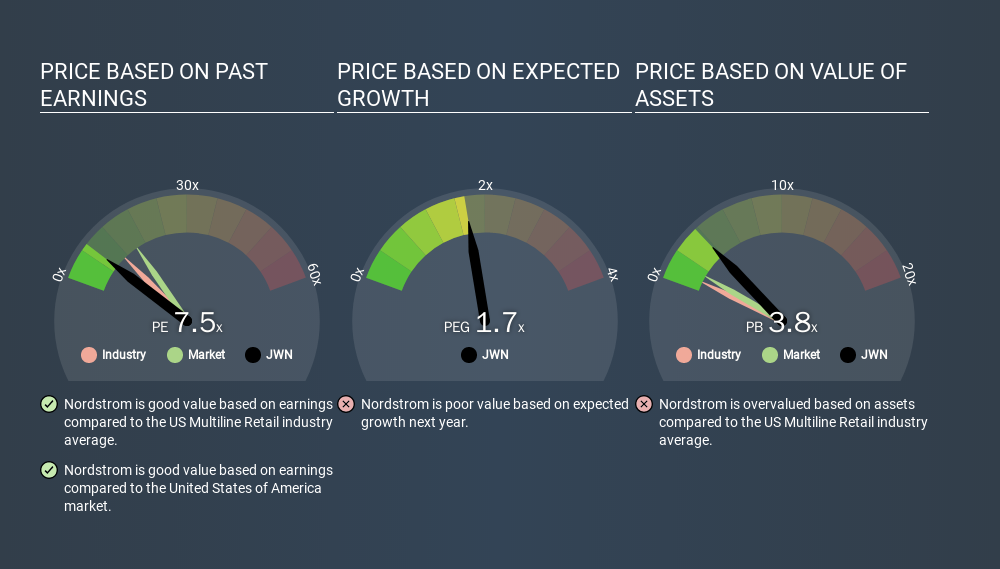What Is Nordstrom's (NYSE:JWN) P/E Ratio After Its Share Price Tanked?

To the annoyance of some shareholders, Nordstrom (NYSE:JWN) shares are down a considerable 38% in the last month. That drop has capped off a tough year for shareholders, with the share price down 46% in that time.
Assuming nothing else has changed, a lower share price makes a stock more attractive to potential buyers. While the market sentiment towards a stock is very changeable, in the long run, the share price will tend to move in the same direction as earnings per share. The implication here is that long term investors have an opportunity when expectations of a company are too low. One way to gauge market expectations of a stock is to look at its Price to Earnings Ratio (PE Ratio). A high P/E ratio means that investors have a high expectation about future growth, while a low P/E ratio means they have low expectations about future growth.
View our latest analysis for Nordstrom
Does Nordstrom Have A Relatively High Or Low P/E For Its Industry?
Nordstrom's P/E of 7.52 indicates relatively low sentiment towards the stock. If you look at the image below, you can see Nordstrom has a lower P/E than the average (10.0) in the multiline retail industry classification.

This suggests that market participants think Nordstrom will underperform other companies in its industry. Since the market seems unimpressed with Nordstrom, it's quite possible it could surprise on the upside. It is arguably worth checking if insiders are buying shares, because that might imply they believe the stock is undervalued.
How Growth Rates Impact P/E Ratios
Generally speaking the rate of earnings growth has a profound impact on a company's P/E multiple. If earnings are growing quickly, then the 'E' in the equation will increase faster than it would otherwise. And in that case, the P/E ratio itself will drop rather quickly. Then, a lower P/E should attract more buyers, pushing the share price up.
Nordstrom saw earnings per share decrease by 5.0% last year. But EPS is up 16% over the last 3 years. And EPS is down 3.3% a year, over the last 5 years. So it would be surprising to see a high P/E.
A Limitation: P/E Ratios Ignore Debt and Cash In The Bank
Don't forget that the P/E ratio considers market capitalization. So it won't reflect the advantage of cash, or disadvantage of debt. Theoretically, a business can improve its earnings (and produce a lower P/E in the future) by investing in growth. That means taking on debt (or spending its cash).
While growth expenditure doesn't always pay off, the point is that it is a good option to have; but one that the P/E ratio ignores.
Nordstrom's Balance Sheet
Nordstrom's net debt equates to 49% of its market capitalization. You'd want to be aware of this fact, but it doesn't bother us.
The Verdict On Nordstrom's P/E Ratio
Nordstrom trades on a P/E ratio of 7.5, which is below the US market average of 14.7. Since it only carries a modest debt load, it's likely the low expectations implied by the P/E ratio arise from the lack of recent earnings growth. What can be absolutely certain is that the market has become more pessimistic about Nordstrom over the last month, with the P/E ratio falling from 12.0 back then to 7.5 today. For those who prefer to invest with the flow of momentum, that might be a bad sign, but for deep value investors this stock might justify some research.
Investors have an opportunity when market expectations about a stock are wrong. If the reality for a company is not as bad as the P/E ratio indicates, then the share price should increase as the market realizes this. So this free visual report on analyst forecasts could hold the key to an excellent investment decision.
Of course, you might find a fantastic investment by looking at a few good candidates. So take a peek at this free list of companies with modest (or no) debt, trading on a P/E below 20.
If you spot an error that warrants correction, please contact the editor at editorial-team@simplywallst.com. This article by Simply Wall St is general in nature. It does not constitute a recommendation to buy or sell any stock, and does not take account of your objectives, or your financial situation. Simply Wall St has no position in the stocks mentioned.
We aim to bring you long-term focused research analysis driven by fundamental data. Note that our analysis may not factor in the latest price-sensitive company announcements or qualitative material. Thank you for reading.
About NYSE:JWN
Solid track record with adequate balance sheet.
Similar Companies
Market Insights
Community Narratives





